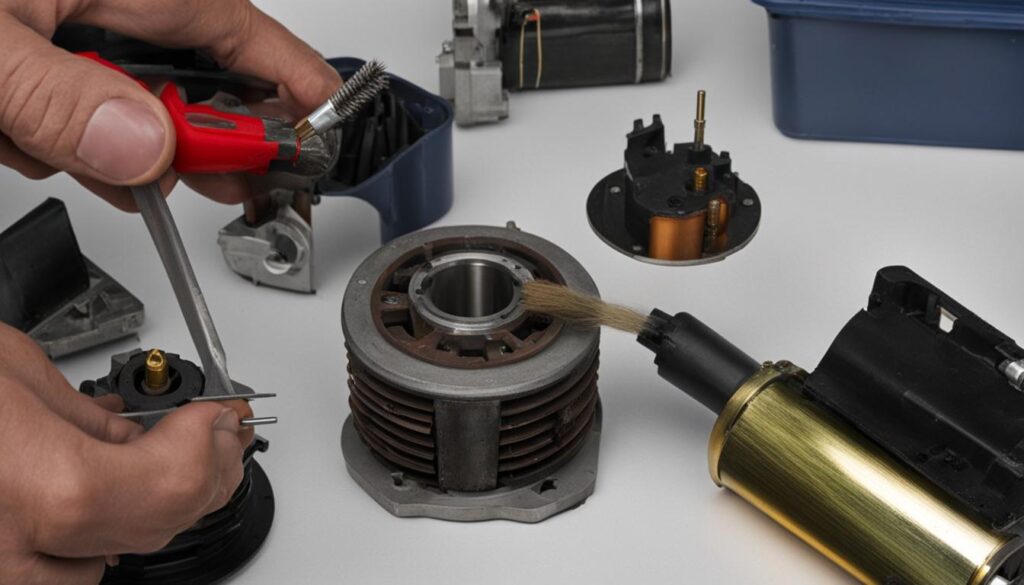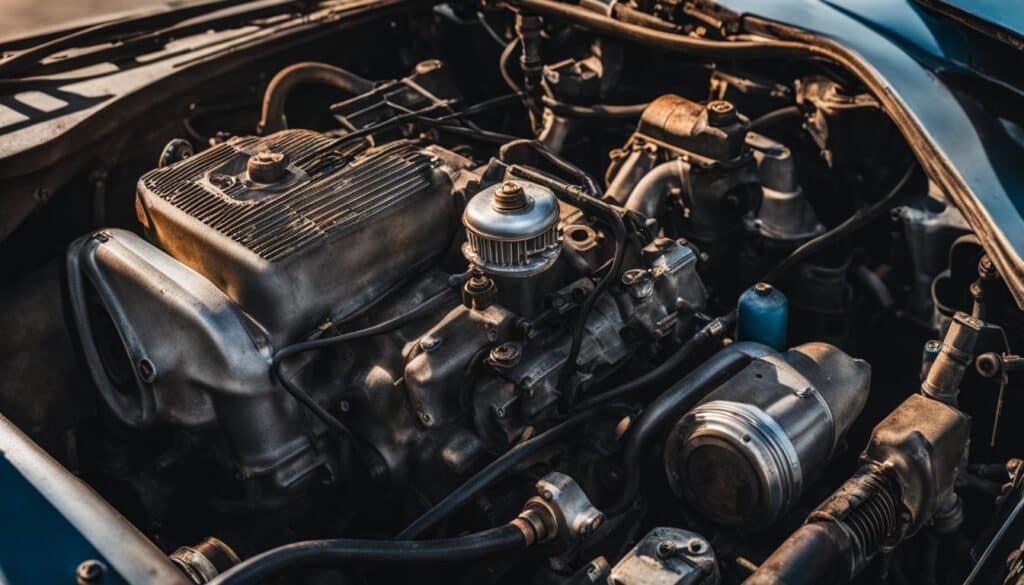Hey there! If you’ve been experiencing issues with your car’s starter motor, you’ve come to the right place. I’m here to guide you through troubleshooting and fixing common starter motor problems, so your car can get back on the road in no time.
A starter motor is a vital component of your car’s ignition system. It’s responsible for starting the engine by engaging the ring gear mounted to the flywheel. Unfortunately, like any mechanical part, starter motors can encounter problems over time, leading to frustrating car starter issues.
You may have noticed some signs that indicate a faulty starter motor. Perhaps your engine won’t turn over, or you hear a clicking noise when you try to start your car. In some cases, the starter motor may stay on or nothing happens at all when you turn the key. These are all indicators that your starter motor is not working as it should.
But don’t worry, there are steps you can take to troubleshoot and fix the issue. By inspecting the electrical connections, testing the starter off the engine, checking for damage, and replacing faulty components, you can tackle starter motor problems head-on.
Remember, if your starter motor is beyond repair, it may need to be replaced. This may seem daunting, but with the right information and guidance, you’ll be able to solve this problem and get your car running smoothly again.
Key Takeaways:
- Common signs of a faulty starter motor include the engine not turning over, a clicking noise when attempting to start the car, the starter motor staying on, or no response when turning the key.
- Starter motor problems can be caused by loose electrical connections, faulty internal windings or brushes, bad bearings, damaged teeth on the starter or ring gear, or a stuck solenoid.
- Troubleshooting starter motor problems involves inspecting electrical connections, testing the starter off the engine, checking for damage to bolts and gears, and potentially replacing faulty components.
- If the starter motor is beyond repair, it may need to be replaced entirely.
- Regular inspection and maintenance of the starter motor can help prevent future issues and ensure reliable starting of your car.
Signs of a Faulty Starter Motor
When it comes to starter motor problems, there are several signs that indicate something is amiss. Ignoring these signs can lead to more serious issues down the line, so it’s crucial to address them promptly. One of the most common signs of a faulty starter motor is when the engine fails to turn over despite the starter engaging.
This issue can be caused by loose or corroded electrical connections, mechanical problems like bad bearings or damaged teeth on the starter or ring gear, or a faulty solenoid. If you experience difficulty starting your car and hear a clicking noise when turning the key, it’s a strong indication that the starter motor is not able to crank the engine.
Loose or corroded electrical connections may be the culprit behind this clicking noise. Additionally, the problem could stem from worn-out brushes or internal windings in the starter motor, or even a worn-out Bendix. Regardless of the exact cause, a clicking noise when starting your car is not a sound you should ignore.
Addressing the signs of a faulty starter motor is crucial to ensure the reliable operation of your vehicle. In the next section, we’ll delve into troubleshooting and fixing starter motor problems to help you get back on the road with confidence.
Key Points:
- Engine fails to turn over despite the starter engaging
- Clicking noise when turning the key
- Possible causes include loose or corroded electrical connections, mechanical issues, or a faulty solenoid
Troubleshooting and Fixing Starter Motor Problems
When faced with starter motor problems, it’s essential to follow a systematic approach to diagnose and fix the issue. Here’s a step-by-step guide on how to troubleshoot and resolve common starter motor problems.
Inspect Electrical Connections
The first step in troubleshooting a faulty starter motor is to check the electrical connections. Start by inspecting the connections between the starter, battery, earth, and solenoid. Ensure that all connections are clean, tight, and free from corrosion. Corroded or loose connections can prevent the starter from receiving the necessary power to function properly.
If you find any corroded or loose connections, clean them using a wire brush and reconnect them securely. This simple maintenance task can often resolve starter motor issues.
Test the Starter Off the Car
If the electrical connections are in good condition and the problem persists, the next step is to remove the starter from the engine and test it off the car. This test will help determine if the starter has issues with its internal windings or brushes.
Here’s how to test the starter off the car:
- Disconnect the electrical connections from the starter.
- Securely attach jumper cables to the starter’s solenoid terminals.
- Connect the positive jumper cable to the positive terminal of a fully charged battery.
- Connect the negative jumper cable to the negative terminal of the battery.
- Using insulated pliers, touch the small terminal on the starter solenoid with the positive jumper cable.
- If the starter spins freely and sounds smooth, it indicates that the internal windings and brushes are working correctly. In this case, the issue may lie elsewhere in the ignition system.
- If the starter fails to spin or makes grinding noises, it suggests internal problems with the windings or brushes. In such cases, rebuilding or replacing the starter may be necessary.
Check for Damage or Wear
In addition to the electrical and internal component checks, it’s important to examine the starter for any visible damage or wear. Inspect the starter’s bolts and gears for signs of damage or excessive wear. If the ring gear on the flywheel is damaged, it may require a gearbox-off job to fix it. Addressing these mechanical issues will help restore the starter’s functionality.
Consult Manuals or Seek Specialist Help
During the troubleshooting and fixing process, it’s crucial to follow proper procedures. Consult a reputable automotive manual like Haynes or seek assistance from a trusted specialist if needed. This ensures that you perform the necessary steps correctly and prevent any further damage to the starter motor or the car’s ignition system.
Remember, troubleshooting and fixing starter motor problems require patience, attention to detail, and the right tools. By following these steps and seeking professional guidance when necessary, you can successfully resolve starter motor issues and enjoy reliable car starting.

Conclusion
Starter motor problems are common issues that car owners may encounter. When experiencing a faulty starter motor, common signs include the engine not turning over, a clicking noise, the starter motor staying on, or nothing happening at all when turning the key. These problems can arise from loose electrical connections, faulty internal components, or mechanical issues.
Prompt troubleshooting and fixing of starter motor problems are crucial to ensure the reliable starting of the car. In many cases, simple maintenance and repairs can resolve the issue, such as cleaning electrical connections or replacing faulty components. However, if the starter motor is beyond repair, it may be necessary to replace it.
Regular inspection and maintenance of the starter motor can help prevent future issues and ensure the smooth operation of the car’s ignition system. By addressing common starter motor problems promptly and implementing proper maintenance practices, car owners can enjoy a hassle-free driving experience.
FAQ
What are the common signs of a faulty starter motor?
Common signs of a faulty starter motor include the engine not turning over, a clicking noise when trying to start the car, the starter motor staying on, or nothing happening at all when the key is turned.
What can cause a clicking noise when trying to start the car?
A clicking noise when turning the key can be a result of loose or corroded electrical connections, bad brushes or internal windings, or a worn-out Bendix in the starter motor.
How can I troubleshoot and fix starter motor problems?
To troubleshoot starter motor problems, inspect the electrical connections, test the starter for proper function off the engine, check the starter’s bolts and gears for damage, and replace any faulty components as needed. If the starter motor is beyond repair, it may need to be replaced.
What should I do if my starter motor is not working?
If your starter motor is not working, properly inspect and test the electrical connections, and check for any signs of damage or wear on the starter’s components. If necessary, consult a professional for further assistance in troubleshooting and fixing the problem.




